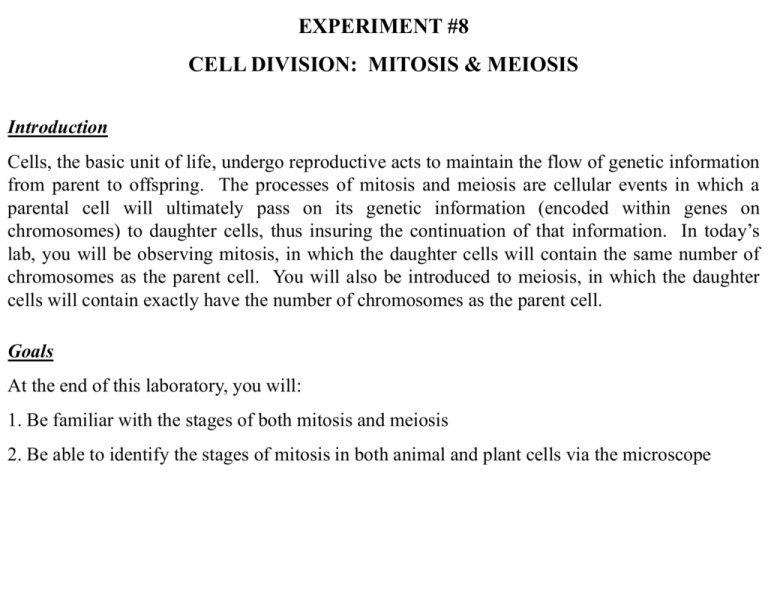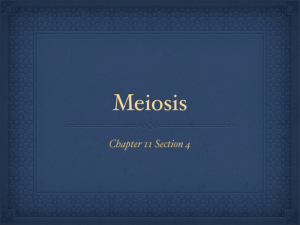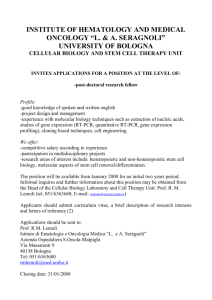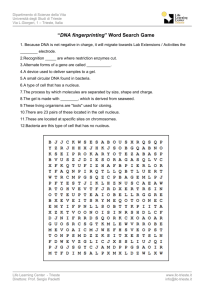experiment #8 cell division: mitosis & meiosis
advertisement

EXPERIMENT #8 CELL DIVISION: MITOSIS & MEIOSIS Introduction Cells, the basic unit of life, undergo reproductive acts to maintain the flow of genetic information from parent to offspring. The processes of mitosis and meiosis are cellular events in which a parental cell will ultimately pass on its genetic information (encoded within genes on chromosomes) h ) to daughter d h cells, ll thus h insuring i i the h continuation i i off that h information. i f i I today’s In d ’ lab, you will be observing mitosis, in which the daughter cells will contain the same number of chromosomes as the parent cell. You will also be introduced to meiosis, in which the daughter cells ll will ill contain t i exactly tl have h th number the b off chromosomes h as the th parentt cell. ll Goals At the end of this laboratory, you will: 1. Be familiar with the stages of both mitosis and meiosis 2. Be able to identify the stages of mitosis in both animal and plant cells via the microscope EXPERIMENT #8 CELL DIVISION: MITOSIS & MEIOSIS Experimental Procedure A. Mitosis Mitosis, the process of cell division, is actually a part of a much larger process called the CELL CYCLE. The cell cycle is composed of 4 stages: G1 (growth or gap), S (synthesis of DNA), G2 (growth or gap), and M (mitosis). In order for a parental cell to divide into two daughter cells, it must be “prepared” for this division. The growth phases occur both before and after the DNA synthesis y stage g and are involved in pproducing g the necessaryy cellular components p for the act of division. The S phase is involved in duplicating the DNA so that each daughter cell will receive one set of chromosomes. The stages of G1, S, and G2 are collectively referred to as INTERPHASE. As soon as the cell exits G2, mitosis begins and the following events occur: Prophase, Metaphase, Anaphase, and Telophase. These are the four stages of mitosis, and very specific cellular events occur during each stage to insure that the cell divides properly. The following slides will illustrate and characterize each of these four stages of mitosis, as well as the starting interphase stage. EXPERIMENT #8 CELL DIVISION: MITOSIS & MEIOSIS Experimental Procedure A. Mitosis (continued) 1. Interphase G1, S, G1 S and d G2 stages compose interphase. i h Thi stage is This i a period i d off growthh andd DNA duplication. d li i Visually, the cell looks like a typical cell with a defined cell and nuclear membrane. The contents of the nucleus are diffuse and appear to contain millions of stained dots (nuclear material). The f ll i slides following lid depict d i t interphase i t h i both in b th an animal i l cell ll (whitefish) ( hit fi h) andd plant l t cell ll (allium ( lli roott tip) EXPERIMENT #8 CELL DIVISION: MITOSIS & MEIOSIS Whitefish Nuclear membrane Cell membrane EXPERIMENT #8 CELL DIVISION: MITOSIS & MEIOSIS Alium root tip Nuclear membrane Cell wall EXPERIMENT #8 CELL DIVISION: MITOSIS & MEIOSIS Experimental Procedure A. Mitosis (continued) 1. Prophase Prophase P h i characterized is h i d by b the h condensation d i off the h diffuse diff chromatin h i into i visible i ibl “strand-like” “ d lik ” chromosomes. Even though you cannot visualize it, the condensed chromosomes are arranged as sister chromatids attached at their centromeres. The cell pictured on the following slides do not h have an intact i t t nuclear l membrane. b A th characteristic Another h t i ti which hi h is i nott visible i ibl on the th following f ll i slides are the centrioles (only in animal cells), which migrate to opposite poles and will become the core of the the microtubule organizing center (MTOC) EXPERIMENT #8 CELL DIVISION: MITOSIS & MEIOSIS Cell membrane Condensed chromosomes EXPERIMENT #8 CELL DIVISION: MITOSIS & MEIOSIS Condensed chromosomes EXPERIMENT #8 CELL DIVISION: MITOSIS & MEIOSIS Experimental Procedure A. Mitosis (continued) 1. Metaphase The simplest Th i l phase h off mitosis i i to identify id if is i characterized h i d by b the h “lining “li i up”” off the h chromosomes h along the metaphase or equatorial plate. Spindle fibers may or may not be visible connecting the centromeres of the sister chromatids to opposite ends of the cell. EXPERIMENT #8 CELL DIVISION: MITOSIS & MEIOSIS Chromosomes MTOC Spindle fibers EXPERIMENT #8 CELL DIVISION: MITOSIS & MEIOSIS Chromosomes EXPERIMENT #8 CELL DIVISION: MITOSIS & MEIOSIS Experimental Procedure A. Mitosis (continued) 1. Anaphase Anaphase A h i characterized is h i d by b the h separation i off the h sister i chromatids h id into i i di id l individual chromosomes. Kinetochore fibers attached to the kinetochore region of the centromere facilitates the movement of the chromosomes toward opposite ends of the cell. The kinetochores ride the ki t h kinetochore fib like fibers lik a train t i on railroad il d track, t k but b t as they th move along l th kinetochore the ki t h fib the fibers th kinetochores disassemble “destroy” the tracks that they have just passed over. This division of the nuclear material is known as karyokinesis. EXPERIMENT #8 CELL DIVISION: MITOSIS & MEIOSIS MTOC Spindle fibers Chromosomes EXPERIMENT #8 CELL DIVISION: MITOSIS & MEIOSIS Chromosomes EXPERIMENT #8 CELL DIVISION: MITOSIS & MEIOSIS Experimental Procedure A. Mitosis (continued) 1. Telophase Telophase T l h i characterized is h i d by b the h completion l i off chromosome h migration i i andd the h reformation f i off the nuclear membrane. Cytokinesis, the process of dividing the cytoplasm, began in anaphase and is now leaving some definitive characteristics during telophase. In animal cells, the appearance off the th cleavage l f furrow i a goodd indication is i di ti that th t the th cell ll has h entered t d telophase. t l h Th The cleavage furrow is an invagination of the cell membrane at the point at which the cell will be split at. In plant cell, the appearance of the cell plate (a precursor to the cell wall) is a characteristic of telophase. telophase EXPERIMENT #8 CELL DIVISION: MITOSIS & MEIOSIS Cleavage furrow Chromosomes EXPERIMENT #8 CELL DIVISION: MITOSIS & MEIOSIS Cell plate Chromosomes EXPERIMENT #8 CELL DIVISION: MITOSIS & MEIOSIS Experimental Procedure B. Meiosis Meiosis is also a process by which there is a division of nuclear material, but instead of producing two daughter cells which contain the same number of chromosomes as the parent, four haploid daughter cells are produced. Each containing only half the number of chromosomes as the parent. The reduction of the chromosome number in these sex cells or gametes is critical for the pprocess of sexual reproduction. p When male and female ggametes combine with each other during fertilization, a zygote containing the proper number of chromosomes for that organismis produced. This single fertilized egg will then undergo mitotic divisions to become a complex multicellular organism with each cell containing the same genetic information encoded for by a set of chromosomes Meiosis is divided into two steps: Meiosis I and Meiosis II. Each step of meiosis is divided into the appropriate Prophase, Prophase Metaphase, Metaphase Anaphase, Anaphase & Telophase stages with the number I or II following it to identify meiosis I or meiosis II. Let us look at the stages of meiosis in order beginning with prophase I. EXPERIMENT #8 CELL DIVISION: MITOSIS & MEIOSIS Experimental Procedure B. Meiosis - Prophase I Prior to prophase I the cell completed a typical interphase stage where the cell grew and DNA was synthesized. During prophase I, the same events that occurred in mitosis also occur here. The chromatin condenses into visible chromosomes, the nuclear membrane disintegrates, and centrioles migrate toward opposite poles. The unique event that occurs during prophase I is synapsis y p where homologous g chromosomes line upp and fuse together. g This fusion allows the exchange of genetic material between two chromosomes in a process called crossing over. The following pictures are examples of prophase I and synapsis. EXPERIMENT #8 CELL DIVISION: MITOSIS & MEIOSIS EXPERIMENT #8 CELL DIVISION: MITOSIS & MEIOSIS EXPERIMENT #8 CELL DIVISION: MITOSIS & MEIOSIS Experimental Procedure B. Meiosis - Metaphase I During metaphase I, the pairs of homologous chromosomes line up on the metaphase plate. This is distinct from mitosis, where each replicated chromosome lines up by itself on the metaphase plate. This is due to the synapsis event during prophase I. EXPERIMENT #8 CELL DIVISION: MITOSIS & MEIOSIS EXPERIMENT #8 CELL DIVISION: MITOSIS & MEIOSIS Experimental Procedure B. Meiosis - Anaphase I A pair of sister chromatids are separated from there homologous pair during anaphase I. Again this is different from mitosis in which individual sister chromatids are moved to opposite ends of the cell. EXPERIMENT #8 CELL DIVISION: MITOSIS & MEIOSIS EXPERIMENT #8 CELL DIVISION: MITOSIS & MEIOSIS Experimental Procedure B. Meiosis - Telophase I Telophase I involves the division and separation of two daughter cells. The genetic make-up of these daughter cells is haploid. Even though they contain the same number of sister chromatids that you would find in the original parent cell, chromosomes are counted based on the number of centromeres present in the cell. Since the sister chromatids are attached at the centromere, they contain only y half the number of centromeres ppresent in the pparent cell and thus half the chromosomes = haploid. EXPERIMENT #8 CELL DIVISION: MITOSIS & MEIOSIS EXPERIMENT #8 CELL DIVISION: MITOSIS & MEIOSIS EXPERIMENT #8 CELL DIVISION: MITOSIS & MEIOSIS Experimental Procedure B. Meiosis - Prophase II and Metaphase II Essentially another prophase stage, without the synapsis event. The same cellular events that take place during prophase of mitosis occur. During metaphase, replicated chromosomes line up on the metaphase plate just like in mitosis. EXPERIMENT #8 CELL DIVISION: MITOSIS & MEIOSIS EXPERIMENT #8 CELL DIVISION: MITOSIS & MEIOSIS Experimental Procedure B. Meiosis - Anaphase II and Telophase II Anaphase II involves the separation of sister chromatids and Telophase II deals with packaging them into distinct gametes (sex cells) which contain half the number of chromosomes as the parent cell. EXPERIMENT #8 CELL DIVISION: MITOSIS & MEIOSIS EXPERIMENT #8 CELL DIVISION: MITOSIS & MEIOSIS EXPERIMENT #8 CELL DIVISION: MITOSIS & MEIOSIS Experimental Procedure C. Aberrations in Meiosis - Non-disjunction The ability of organisms to produce viable offspring lies in the proper re-establishment of the diploid number of chromosomes. Human cells possess 46 chromosomes arranged in 23 pairs. Each parent contributes 23 chromosomes via their sperm or egg to re-establish this diploid number. If there is a defect in the meiotic processes in the male or female, aberrant gametes can be pproduced which contain abnormal numbers of chromosomes. Non-disjunction is the failure of homologous chromosomes to separate during anaphase I or anaphase II. This result in the production of gametes containing 1 extra or 1 less chromosome. When combined with a normal gamete, gamete the resulting fertilized egg and hence the offspring would contain 1 extra or 1 less chromosome (i.e. 45 or 47). Possessing one extra or one less chromosome can lead to serious birth defects or miscarriages. The information carried in exactly 46 chromosomes is so precise that possessing one extra or one less can inhibit the developmental processes of the child to be. EXPERIMENT #8 CELL DIVISION: MITOSIS & MEIOSIS Conclusions Hopefully, this tutorial has been insightful for the upcoming laboratory. You should be prepared for the following tasks: 1. Identification of the mitotic stages in both animal and plant cells 2. Understand the overall cell cycle and how mitosis is a phase of it. 3. Understand the similarities and differences between mitosis and meiosis. 4. Understand the consequences of errors in meiosis, specifically non-disjunction.


